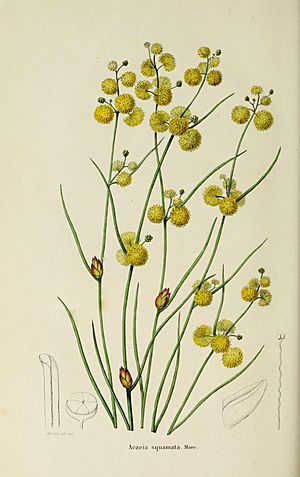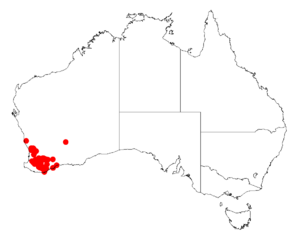Acacia squamata facts for kids
Quick facts for kids Acacia squamata |
|
|---|---|
 |
|
| Illustration of Acacia squamata | |
| Scientific classification | |
| Genus: |
Acacia
|
| Species: |
squamata
|
 |
|
| Occurrence data from AVH | |
Acacia squamata is a type of shrub that belongs to the Acacia family. It is a special plant because it grows only in the southwestern part of Australia. This means it is "endemic" to that area.
About This Plant
This plant is a shrub that usually stands upright. Sometimes, its branches might trail along the ground. It typically grows to be about 0.1 to 0.6 meters (which is about 4 inches to 2 feet) tall. It often has many smooth, hairless stems. These stems are flexible and can be green or grey-green.
Like most Acacia species, this plant does not have true leaves. Instead, it has special flattened stems called phyllodes. These phyllodes look like the stems and are grey-green. They are usually 2 to 7 centimeters long (about 1 to 3 inches) and 1 to 2 millimeters wide. Sometimes, they have a slightly hooked shape at the end.
Acacia squamata blooms from July to September. It produces beautiful yellow flowers. These flowers grow in round clusters, with each cluster having 6 to 11 golden-colored flowers. After the flowers, flat, tough seed pods form. These pods are long and narrow, growing up to 8 centimeters (about 3 inches) long and 4 to 5 millimeters wide. Inside the pods, there are dull or shiny brown seeds. The seeds are about 4 millimeters long and are arranged lengthwise.
Plant History
The first time this plant was officially collected and studied was in 1839. It was found by a botanist named James Drummond.
Where It Grows
Acacia squamata is found in several regions of Western Australia. These areas include the Wheatbelt, Great Southern, and South West regions.
It mostly grows in gravelly soils that contain a type of rock called laterite. You can find it from places like Bindoon in the northwest down to Mount Barker. It also extends east to Fitzgerald River National Park and northeast to Newdegate. This plant thrives in different environments, including sandy or loamy soils. It is often found growing in Eucalyptus woodlands, open heathlands, or scrubland areas.

